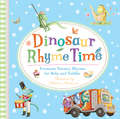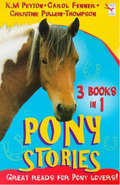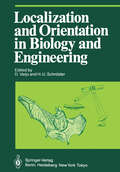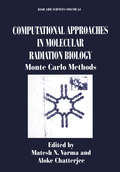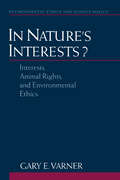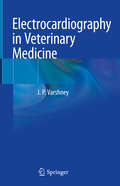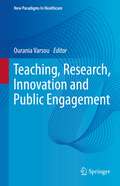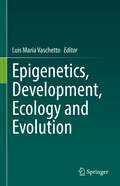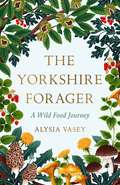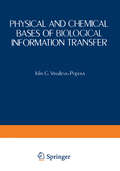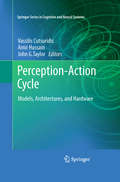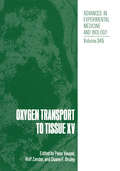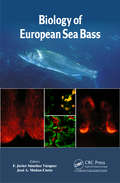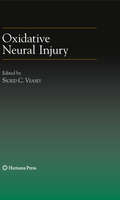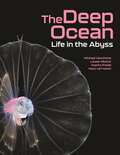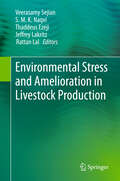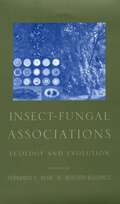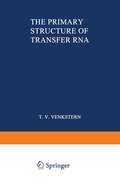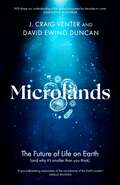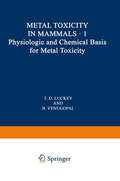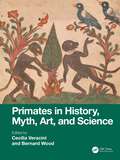- Table View
- List View
Dinosaur Rhyme Time
by VariousAll your favourite nursery rhymes seen as never before with a cast of cute and cuddly dinosaurs playing the leading roles! With favourite nursery rhymes including Oh the Grand Old Duke of York and Little Miss Muffet, as well as singalong classics such as the Wheels on the Bus and If You're Happy and You Know It, children will love this adorable and unique collection - rhyme time has never been such fun!Contains: Row, row, row your boat; Oh, the Grand old Duke of York; Little Miss Muffet; Jack and Jill; Doctor Foster; One, two buckle my shoe; The Wheels on the Bus; Round and round the garden; Mary, Mary; Humpty Dumpty; I'm a Little teapot; If you're happy and you know it; Lavender's blue; Ring a ring a roses; Twinkle Twinkle and Rock-a-bye Baby.
Dogs Hanging Out Of Windows
by VariousEars flapping, eyes wide and nose twitching: a dog hanging out of a window is a spectacular sight. Capturing these moments of delight and canine curiosity, this book is an anthology of beautiful photographs of man's best friend in motion. Dogs of all shapes and sizes from all over the world, majestically alert and gazing triumphantly towards the horizon. Whether cute, powerful, uplifting or heart-warming, these striking images stir up the emotions of joy we feel towards our loveable companions.In over ninety-five stunning portraits, this collection showcases some of the best and most vibrant pet photography from around the globe.
Pony Stories (3 Book Bind-Up)
by VariousA Summer of Horses by Carol Fenner - Faith battle with her fear of horses as she learns to ride on a farm holiday. Fly-By-Night by K. M. Peyton - Ruth learns that keeping a pony is harder than she'd thought. Three to Ride by Christine Pullein-Thompson - David discovers that making it to the top as a show-jumper is going to be a bumpy ride.
Localization and Orientation in Biology and Engineering (Proceedings in Life Sciences)
by D. Varju H. U. SchnitzlerThe German Society of Cybernetics organizes international conferences on selected interdisciplinary topics in regular 3-year intervals. The aim of these meetings is to bring together scientists who work in quite different disciplines, but are confronted with related problems and use the same or similar approaches. The topic of the 1983 conference which was held on March 23-25 at the University of Tiibingen came from a typical field of research in which engineers, biologists, and phYSicists share a common interest. We do not want to discuss here in detail the common principles which are used by nature and by engineers to solve the problems associated with localization and orientation, since the reader will find enough examples in this volume. The question, however, whether the participants of such meetings can really profit from each other, deserves some further consid eration. First, there is the difficulty of finding a common language. This still seems to be a problem, although in some fields the language of engineers and biologists has become very similar over the years, an impression we also gained during the conference. Most of the authors made a great ef fort to use a vocabulary which is understandable to people outside their own field of research, but, admittedly, not all succeeded.
Computational Approaches in Molecular Radiation Biology: Monte Carlo Methods (Basic Life Sciences #63)
by Matesh N. Varma Aloke ChatterjeeThe Office of Health and Environmental Research (OHER) has supported and continues to support development of computational approaches in biology and medicine. OHER's Radiological and Chemical Physics Program initiated development of computational approaches to determine the effects produced by radiation of different quality (such as high energy electrons, protons, helium and other heavy ions, etc. ) in a variety of materials of biological interest-such as water, polymers and DNA; these include molecular excitations and sub-excitations and the production of ionization and their spatial and temporal distribution. In the past several years, significant advances have been made in computational methods for this purpose. In particular, codes based on Monte Carlo techniques have ·been developed that provide a realistic description of track-structure produced by charged particles. In addition, the codes have become sufficiently sophisticated so that it is now possible to calculate the spatial and temporal distribution of energy deposition patterns in small volumes of subnanometer and nanometer dimensions. These dimensions or resolution levels are relevant for our understanding of mechanisms at the molecular level by which radiations affect biological systems. Since the Monte Carlo track structure codes for use in radiation chemistry and radiation biology are still in the developmental stage, a number of investigators have been exploring different strategies for improving these codes.
In Nature's Interests?: Interests, Animal Rights, and Environmental Ethics (Environmental Ethics and Science Policy Series)
by Gary E. VarnerThis book offers a powerful response to what Varner calls the "two dogmas of environmental ethics"--the assumptions that animal rights philosophies and anthropocentric views are each antithetical to sound environmental policy. Allowing that every living organism has interests which ought, other things being equal, to be protected, Varner contends that some interests take priority over others. He defends both a sentientist principle giving priority to the lives of organisms with conscious desires and an anthropocentric principle giving priority to certain very inclusive interests which only humans have. He then shows that these principles not only comport with but provide significant support for environmental goals.
Electrocardiography in Veterinary Medicine
by J.P. VarshneyThis book provides essential information on methodologies for recording electrocardiograms in various animal species, including dogs, cats, cattle, buffaloes, sheep, goats, mithun, chelonians, snakes, avians, equines, rabbits, and the Indian gray mongoose. It also reviews the electrocardiographic physiology, generation of electrocardiograms, and normal criteria for various animal species; electrocardiograms in health and disease; and the interpretation of abnormal electrocardiograms, cardiomyopathy and arrhythmias, with corresponding treatment protocols.Further, it presents several approaches to interpreting the electrocardiograms of dogs, cats, ruminants, tortoises, pigeons, and other animals, offering a valuable resource for all veterinary students, scientists, and physicians wanting to make greater use of this valuable non-invasive tool in the diagnosis of heart diseases and general health examinations.
Teaching, Research, Innovation and Public Engagement (New Paradigms in Healthcare)
by Ourania VarsouThis volume is a unique compendium of professional and practical knowledge on new paradigms and approaches in Teaching, Research, Innovation and Public Engagement that is currently missing from the Higher Education market. The intended audience includes healthcare, biomedical and physical sciences discipline specialists active in teaching, along with their students, science communicators associated with the above subjects and academics involved in relevant research/innovation. Its contents will be organised under the following three themes: 1) Scholarship of Teaching and Learning discussing pertinent knowledge, in this area, and inspiring educators to pursue similar medical humanities endeavours. The focus is on pedagogy/teaching including professional knowledge/expertise, reflections, literature reviews and evidence on a wide range of medical, biomedical and physical sciences topics interweaved with humanities. 2) Research and Innovation discussing novel work and paradigms as examples for future use/implementation. The focus is firstly on original research utilising cutting-edge technology and secondly on innovation with discussions around poetry and building communities. 3) Public Engagement discussing relevant science communication paradigms transferable to other settings and applications. The focus is on practical knowledge and examples from a wide range of healthcare and biomedical sciences topics interweaved with humanities while also exploring the hidden curriculum of public engagement and heritage practices through the lens of equality, diversity and inclusion. All chapter authors are renowned experts in their respective fields, who bring together a wealth of professional and practical knowledge, enriching the narrative of this edited book volume.
Epigenetics, Development, Ecology and Evolution
by Luis María VaschettoEpigenetic modifications comprise heritable gene expression changes that occur without alteration of the DNA sequence and 'co-act' with genetic factors to shape development processes and evolutionary trajectories. Multicellular organisms receive different types of environmental stimuli/stresses that trigger epigenetic modifications during development. These environmentally driven mechanisms represent an underlying cause of phenotypic diversity, especially in metazoans. This book aims to present some of the latest epigenetic insights into the development of metazoans (including humans) as an intersection between their ecology and evolution.
The Yorkshire Forager
by Alysia VaseyAlysia Vasey's earliest memories are of walking alongside her grandfather as they explored the West Yorkshire moors that they called home. As an adult, this love for wild things stayed with her, even as she learnt that her family's knowledge of edible plants were a legacy of a much darker time during the Second World War. After leaving Yorkshire in search of adventure, Alysia was eventually guided home by her motto: Be true to yourself and you will become the person you were meant to be. She left her traditional path and took a far wilder journey that gradually evolved into one of the UK's most successful foraging businesses, supplying some of the greatest chefs in the world and the best restaurants in the country Her achievements are the result of a bit of luck, a lot of knowledge and a huge amount of self-belief. Here, Alysia also shares not only her story, but also her vast knowledge of UK plant lore. A true Yorkshirewoman, Alysia tells it like it is, and The Yorkshire Forager is full of tales of her family's adventures and misadventures in their search for top quality ingredients - you never know who you might meet in the woods - making this book as entertaining as it is informative.
Perception-Action Cycle: Models, Architectures, and Hardware (Springer Series in Cognitive and Neural Systems)
by Vassilis Cutsuridis, Amir Hussain and John G. G. TaylorThe perception-action cycle is the circular flow of information that takes place between the organism and its environment in the course of a sensory-guided sequence of behaviour towards a goal. Each action causes changes in the environment that are analyzed bottom-up through the perceptual hierarchy and lead to the processing of further action, top-down through the executive hierarchy, toward motor effectors. These actions cause new changes that are analyzed and lead to new action, and so the cycle continues. The Perception-action cycle: Models, architectures and hardware book provides focused and easily accessible reviews of various aspects of the perception-action cycle. It is an unparalleled resource of information that will be an invaluable companion to anyone in constructing and developing models, algorithms and hardware implementations of autonomous machines empowered with cognitive capabilities. The book is divided into three main parts. In the first part, leading computational neuroscientists present brain-inspired models of perception, attention, cognitive control, decision making, conflict resolution and monitoring, knowledge representation and reasoning, learning and memory, planning and action, and consciousness grounded on experimental data. In the second part, architectures, algorithms, and systems with cognitive capabilities and minimal guidance from the brain, are discussed. These architectures, algorithms, and systems are inspired from the areas of cognitive science, computer vision, robotics, information theory, machine learning, computer agents and artificial intelligence. In the third part, the analysis, design and implementation of hardware systems with robust cognitive abilities from the areas of mechatronics, sensing technology, sensor fusion, smart sensor networks, control rules, controllability, stability, model/knowledge representation, and reasoning are discussed.
Oxygen Transport to Tissue XV (Advances in Experimental Medicine and Biology #345)
by Peter Vaupel Rolf Zander Duane F. BruleySeventeen years after the 2nd International Symposium on Oxygen Transport to Tissue, which was held in Mainz in March 1975, the local Organizing Committee and the Board of ISOTT were pleased to host the ISOTT Conference in Mainz on the Rhine again. The venue of the 20th meeting was the prestigious, fully restored Schloss Waldthausen (Waldthausen Castle) which provided a special setting for ISOTT 1992. The beautiful front view of the castle became part of the ISOTT 1992 logo. The 20th ISOTT Meeting was held in Mainz from August 26th through August 30th, 1992. The Conference attracted 200 active participants from 16 countries. The theme of this meeting emphasized oxygen transport to tumors but as in earlier meetings, essentially all aspects of oxygen transport within the body were covered as demonstrated by the manuscripts comprising this volume of the series "Oxygen Transport to Tissue". All manuscripts were reviewed. Extensive revisions were made in about 25% and modest revision in about another 30%. Because we had to compromise between the aim of rapid publication on the one hand and the need for thorough review on the other, minor errors in format and some typographical errors were not corrected. Except for some revisions, all of the original camera-ready manuscripts in this volume were prepared by the authors themselves and we greatly appreciate their cooperation.
Biology of European Sea Bass
by F. Javier Sánchez Vázquez José A. Muñoz-CuetoBiology of European Seabass presents up-to-date reviews on key topics of seabass biology, written by leading scientific experts with extensive knowledge of seabass as well as their respective field of expertise. The book covers the biology and ecology of the different sea basses and the latest findings in molecular biology, physiology, and beh
Oxidative Neural Injury (Contemporary Clinical Neuroscience)
by Sigrid C. VeaseyTwenty-five years ago, Earl R. Stadtman, PhD discovered that specific enzymes regulating metabolism can be inactivated by oxidation [1]. He later showed that age-related oxidative modification contributes, at least in part, to age-related loss of function of the enzymes [2, 3]. Dr. Stadtman broke the ground for a new field of study to discover how oxidative stress contributes in significant ways to age-related cellular dysfunction and protein accumulation and that oxidation in the aging brain influences Alzheimer’s disease, ischemia-reperfusion injury, amyotrophic lateral sclerosis, and lifespan [4–6]. Today, his research and mentorship have positively influenced the work of hundreds of scientists in this field. We dedicate this book to Dr. Earl R. Stadtman (1912–2008), in celebration of his passion for science and his superior collaborative and mentorship skills. This book is comprised of three sections. The first describes the valuable roles reactive oxygen species (ROS) and reactive nitrogen species (RNS) play in cellular biology. The second section provides an overview of redox imbalance injury with effects on mitochondria, signaling, endoplasmic reticular function, and on aging in general. The third section takes these mechanisms to neurodegenerative disorders and provides a state-of-the-art look at the roles redox imbalances play in age-related susceptibility to disease and in the disease processes. In the first section we attempt to answer a question posed by Dr. Stadtman, ‘‘Why have cells selected reactive oxygen species to regulate cell signaling events’’ [7].
The Deep Ocean: Life in the Abyss
by Michael Vecchione Louise Allcock Imants Priede Hans van HarenAn epic excursion into one of the last great frontiers on EarthThe deep ocean comprises more than 90 percent of our planet’s biosphere and is home to some of the world’s most dazzling creatures, which thrive amid extreme pressures, scarce food supplies, and frigid temperatures. Living things down here behave in remarkable and surprising ways, and cutting-edge technologies are shedding new light on these critically important ecosystems. This beautifully illustrated book leads you down into the canyons, trenches, and cold seeps of the watery abyss, presenting the deep ocean and its inhabitants as you have never seen them before.Features a wealth of breathtaking photos, illustrations, and graphicsGives a brief and accessible history of deep-sea explorationExplains the basics of oceanographyCovers a marvelous diversity of undersea organismsDescribes habitats ranging from continental slopes to hydrothermal vents and abyssal plainsDiscusses humanity’s impacts on the deep ocean, from fisheries and whaling to global climate change and acidificationWritten by a team of world-class scientists
Environmental Stress and Amelioration in Livestock Production
by Veerasamy Sejian, S.M.K. Naqvi, Thaddeus Ezeji, Jeffrey Lakritz and Rattan LalGiven the importance of livestock to the global economy, there is a substantial need for world-class reference material on the sustainable management of livestock in diverse eco-regions. With uncertain climates involving unpredictable extreme events (e.g., heat, drought, infectious disease), environmental stresses are becoming the most crucial factors affecting livestock productivity. By systematically and comprehensively addressing all aspects of environmental stresses and livestock productivity, this volume is a useful tool for understanding the various intricacies of stress physiology. With information and case studies collected and analyzed by professionals working in diversified ecological zones, this book explores the influence of the environment on livestock production across global biomes. The challenges the livestock industry faces in maintaining the delicate balance between animal welfare and production are also highlighted.
Insect-Fungal Associations: Ecology and Evolution
by Fernando E. Vega Meredith BlackwellInsects and fungi have a shared history of association in common habitats where together they endure similar environmental conditions, but only recently have mycologists and entomologists recognized and had the techniques to study the intricacies of some of the associations. This new volume covers "seven wonders of the insect-fungus world" for which exciting new results have become available, often due to the use of new methods that include phylogenetic analysis and development of molecular markers. Eleven chapters of the volume are presented in two sections, "Fungi that act against insects" and "Fungi mutualistic with insects" that cover a number of major themes. Examples of necrotrophic parasites of insects are discussed, not only for biological control potential, but also as organisms with population structure and complex multipartite interactions; a beneficial role for symptomless endophytes in broad-leafed plants is proposed; biotrophic fungal parasites with reduced morphologies are placed among relatives using phylogenetic methods; complex methods of fungal spore dispersal include interactions with one or more arthropods; the farming behavior of New World attine ants is compared with that of humans and the Old World fungus-growing termites; certain mycophagous insects use fungi as a sole nutritional resource; and other insects obtain nutritional supplements from yeasts. Insects involved in fungal associations include--but are not limited to--members of the Coleoptera, Diptera, Homoptera, Hymenoptera, and Isoptera. The fungi involved in interactions with insects may be clustered taxonomically, as is the case for Ascomycetes in the Hypocreales (e.g., Beauveria, Metarhizium, Fusarium), ambrosia fungi in the genera ophiostoma and ceratocystis and their asexual relatives, Laboulbeniomycetes, Saccharomycetes, and the more basal Microsporidia. Other groups, however, have only occasional members (e.g., mushrooms cultivated by attine ants and termites) in such associations. The chapters included in this volume constitute a modern crash course in the study of insect-fungus associations.
How To Go Vegan: The why, the how, and everything you need to make going vegan easy
by VeganuaryGoing vegan is easy!Whether you're already a full-time vegan, considering making the switch or know someone who is, this book will give you all the tools you need to make the change towards a healthier, happier and more ethical lifestyle. How to Go Vegan includes...Why try vegan?Animal welfare, the environment, health benefits and your personal adventure.Vegan at homeSurprisingly vegan foods, reading labels, vegan ingredient essentials, easy replacements, how to be the only vegan in the familyVegan out in the worldEating out, eating at friends' houses, answering questions from loved ones, travelling veganLiving the vegan lifestyleMeal plans, tips and tricks, what to do if you're struggling, how to celebrate being a veganHow to go vegan. It's easier than you think.
The Primary Structure of Transfer RNA
by Tat Yana VenksternThe study of the primary structure of nucleic acids, i. e. , the determination of the nucleotide sequence in ribosomal, transfer, and messenger types of RNA and in DNA, is an essential preliminary to the attempt to correlate the structures of these compounds with their functions. This is one of the most urgent problems in molecular biology, for until it is solved it is im possible to understand fully the mechanisms of fundamental living processes. Research has naturally tended to concentrate on the nucleic acids of smallest molecular weight, namely the transfer RNAs, and tremendous progress has been made in recent years in the unraveling of their structure. In 1958-1959, when structural investigation was still in its infancy, it was even doubted whether the structure of any transfer RNA could be deter mined. No methods of isolating homogeneous preparations were available, and it was uncertain whether the very slight physical and chemical differences between tRNAs of different specificity would be sufficient to allow successful fractionation. When the first enriched preparations were obtained, there arose the problem of whether it was possible to determine the nucleotide sequence having regard to the limited number of heterogeneous structural elements present in tRNA. These doubts were resolved in 1965, when the structure of the first nucleic acid, alanine-specific transfer RNA, was unraveled in Holley's laboratory.
Microlands: The Future of Life on Earth (and Why It’s Smaller Than You Think)
by J. Craig Venter David Ewing Duncan'An epic travelogue, brimming with the excitement of discovery. With characteristic panache, Venter unveils the teeming array of bacteria, viruses, and eukaryotes that crowd our planet's oceans' - Siddhartha Mukherjee'This page-turner gives . . . the thrill of seeing our planet's largest universe through the brilliant, intrepid eyes of the scientist who has done more than anyone to unlock the secrets of life' - Martine Rothblatt'A tour de force . . . Venter has expanded biology's horizons. This book explores microbial life on a global scale, providing cutting-edge solutions to problems of environmental change' - Aristides Patrinos'A ripping tale . . . to revolutionize our understanding of our bodies, the oceans, and the planet' - Jack Gilbert'An exhilarating account of how creative science is accomplished' - Sir Richard J. Roberts'[A] fascinating tour of Planet Microbe' - Bill McKibben'Venter and Duncan expand our scope of what it means to be alive' - Jamie Metzl'Inspiring ... change[s] our ideas of how biology is done' - TelegraphUpon completing his historic work on the Human Genome Project in 2002, J. Craig Venter declared that he would sequence the genetic code of all life on earth. Thus began a fifteen-year quest to collect DNA from the world's oldest and most abundant form of life: microbes. Boarding the Sorcerer II, a 100-foot sailboat turned research vessel, Venter travelled over 65,000 miles around the globe to sample ocean water and the microscopic life within.In this book, Venter and science writer David Ewing Duncan tell the remarkable story of these expeditions and of the momentous discoveries that ensued-of plant-like bacteria that get their energy from the sun, proteins that metabolize vast amounts of hydrogen, and microbes whose genes shield them from ultraviolet light. The result was a massive library of millions of unknown genes, thousands of unseen protein families, and new lineages of bacteria that revealed the unimaginable complexity of life on earth. Yet despite this exquisite diversity, Venter encountered sobering reminders of how human activity is disturbing the delicate microbial ecosystem that nurtures life on earth. In the face of unprecedented climate change, Venter and Duncan show how we can harness the microbial genome to develop alternative sources of energy, food, and medicine that might ultimately avert our destruction.A captivating story of exploration and discovery, this book restores microbes to their rightful place as crucial partners in our evolutionary past and guides to our future.
Physiologic and Chemical Basis for Metal Toxicity
by B. VenugopalOur purpose is to provide understanding for appropriate use of metals in a technical society. Knowledge of metal toxicity is needed for the preven tion, prediction, diagnosis, and therapy of adverse reactions from excess metals in mammals. Metal Toxicity in Mammals is presented in two volumes. Volume 1, Physiologic and Chemical Basis for Metal Toxic ity, provides the basis for understanding the toxic actions of metals recorded in Volume 2, Chemical Toxicity of Metals and Metalloids. The details and bases for many concepts summarized in Volume I are given, with appropriate references, in Volume 2. Thus, references for specific items in Volume 2 are not generally given in Volume 1. The authors reviewed the known toxicity of several heavy metals in anticipation of their use as multinutrient markers for NASA. As more and more metals were considered, the need for a complete review became obvious. This treatise supplants onerous searches of metal-toxicity litera ture up to 1975 and reviews the toxicity of all the metals of the periodic table on the basis of available relevant data. Books on pharmacological, nutritional, medical, veterinary, or industrial toxicity contain information about selected metals. More complete data about metals of public concern, such as mercury, lead, and cadmium, may be found in numerous books and reviews. The reader should refer to general texts and basic reference works, when specific references are not given, for general information.
Primates in History, Myth, Art, and Science
by Cecilia Veracini Bernard WoodNon-human primates (hereafter just primates) play a special role in human societies, especially in regions where modern humans and primates co-exist. Primates feature in myths and legends and in traditional indigenous knowledge. Explorers observed them in the wild and brought them, at great cost, to Europe. There they were valued as pets and for display, their images featured in art and architecture, and where they were literally teased apart by scientists. The international team of contributors to this book draws these different perspectives together to show how primates helped humans better understand their own place in nature. The book will be of interest to undergraduate and graduate students as well scholars in disciplines ranging from anthropology to art history.Key features: Includes contributions from an international team of historians and natural scientists Integrates various perspectives and perceptions of non-human primates across time and place Summarizes the place of non-human primates in science, art and culture Includes rare early illustrations
Primates in History, Myth, Art, and Science
by Cecilia Veracini Bernard WoodNon-human primates (hereafter just primates) play a special role in human societies, especially in regions where modern humans and primates co-exist. Primates feature in myths and legends and in traditional indigenous knowledge. Explorers observed them in the wild and brought them, at great cost, to Europe. There they were valued as pets and for display, their images featured in art and architecture, and where they were literally teased apart by scientists. The international team of contributors to this book draws these different perspectives together to show how primates helped humans better understand their own place in nature. The book will be of interest to undergraduate and graduate students as well scholars in disciplines ranging from anthropology to art history.Key features: Includes contributions from an international team of historians and natural scientists Integrates various perspectives and perceptions of non-human primates across time and place Summarizes the place of non-human primates in science, art and culture Includes rare early illustrations
